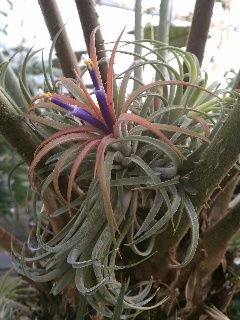
Tillandsia are often grown in containers such as terrariums or hanging globes; if you use this sort of vessel, be aware that heat can build inside while the sun shines on it. Take care to position such a container away from direct sunlight.
Another special consideration needed for Tillandsia is that without roots or a pot, its going to need to be watered a bit differently than your other houseplants. Tillandsia should be soaked in room temperature water every two to three days. One quarter strength water-soluble fertilizer can be added to the water about twice a month. Use distilled or rain water to prevent minerals from building up on the leaves.
After watering, ensure that the plant is not left with standing water between the leaves and that they dry within a few hours. Tillandsia need good air circulation to thrive, so if you keep your plant in a glass container it should have an ample opening for air flow. Plants mounted on wood, in shells, or other open-air supports can be misted in between waterings but take care that they still get to dry down; excess moisture can quickly cause Tillandsia to rot.
Tillandsia reproduce by sending out offshoots which can be left connected to the parent plant or gently twisted free and given a place of their own. Root growth may or may not occur and so cannot be used as a gauge of the young plant's maturity. Instead, let the new plant's size relative to the parent plant be your guide. A good target would be for the baby to be at least one third the size of the mother plant before separation.


